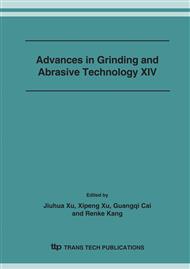p.409
p.414
p.420
p.425
p.431
p.436
p.441
p.445
p.450
Modeling of Material Removal Rate in Two-Dimensional Ultrasonic Grinding Complex Ceramics
Abstract:
Based on the machining pattern, mechanics of material removal and theory of micro-indentation, in previous studies the models of material removal rate of hard-brittle materials was discussed through the relatively influencing factors of machining parameters from various aspects, reflecting the research advances on mechanics of material removal of hard-brittle materials. However, those models of material removal rate have limitations, which results from impercipient theory of fracture of new kinks of materials, randomicity of practical machining process, inappropriate assumptions and simplification of the machining conditions and so on. In this work firstly, previous models of material removal rate of hard-brittle materials machining with ultrasonic assistance were reviewed briefly. Subsequently, the models of material removal rate of complex ceramics machining with two-dimensional ultrasonic vibration assistance were established based on fracture theory of micro- indentation in fracture regime and plastic removal mechanics in ductile regime respectively. The material removal rate is affected not only by the properties of material and machining parameters, but also by the character of grinding wheel and parameters of ultrasonic vibration.
Info:
Periodical:
Pages:
431-435
Citation:
Online since:
November 2007
Authors:
Price:
Сopyright:
© 2008 Trans Tech Publications Ltd. All Rights Reserved
Share:
Citation:


